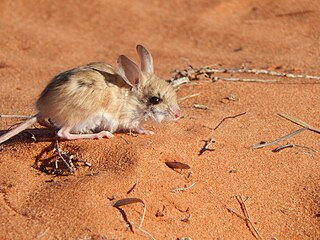
The dusky hopping mouse, is a small rodent endemic to Australia, inhabiting desert regions characterised by sand dunes. Populations have experienced significant declines since the arrival of Europeans, and continue to be subject to threatening processes. It is currently listed as a threatened species.

The red-tailed hawk is a bird of prey that breeds throughout most of North America, from the interior of Alaska and northern Canada to as far south as Panama and the West Indies. It is one of the most common members within the genus of Buteo in North America or worldwide. The red-tailed hawk is one of three species colloquially known in the United States as the "chickenhawk", though it rarely preys on standard-sized chickens. The bird is sometimes also referred to as the red-tail for short, when the meaning is clear in context.

The South American sea lion, also called the southern sea lion and the Patagonian sea lion, is a sea lion found on the western and southeastern coasts of South America. It is the only member of the genus Otaria. The species is highly sexually dimorphic. Males have a large head and prominent mane. They mainly feed on fish and cephalopods and haul out on sand, gravel, rocky, or pebble beaches. In most populations, breeding males are both territorial and harem holding; they establish territories first and then try to herd females into them. The overall population of the species is considered stable, estimated at 265,000 animals.

The Lessepsian migration is the migration of marine species along the Suez Canal, usually from the Red Sea to the Mediterranean Sea, and more rarely in the opposite direction. When the canal was completed in 1869, fish, crustaceans, mollusks, and other marine animals and plants were exposed to an artificial passage between the two naturally separate bodies of water, and cross-contamination was made possible between formerly isolated ecosystems. The phenomenon is still occurring today. It is named after Ferdinand de Lesseps, the French diplomat in charge of the canal's construction. The term was coined by Francis Dov Por in his 1978 book.

The blackmouth lanternshark is a species of dogfish shark within the family Etmopteridae. This species is part of a subgroup that includes one other species from within the family. It is known to inhabit the benthic zones of the Eastern Indian Ocean and the Arafura Sea. These sharks were first described in a 2002 issue of Cybium, and there is still much unknown about the species.
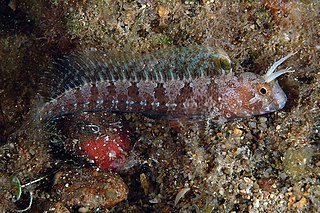
The tentacled blenny is a species of combtooth blenny most commonly found in all parts of the Mediterranean Sea, in the Sea of Marmara and the Black Sea, and the east Atlantic near the coast of Portugal, Spain, Canary Islands, and Morocco south to Guinea. This species reaches a length of 15 centimetres (5.9 in) TL. Found in brackish waters, in estuaries or deltas, this demersal fish can be found in the sand at the bottom of the water in light vegetation. The adult males guards a suitable spot, which a few females may visit and deposit their eggs, the males fertilizes the eggs and guards them until they hatch.
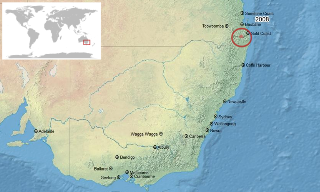
Loveridge's frog, also known as the masked mountain frog, is a species of frogs in the family Limnodynastidae.
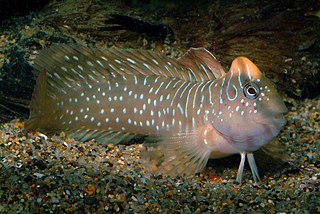
Salaria is a genus of fish in the family Blenniidae. It now contains marine species which are found around the Mediterranean Sea and the eastern Atlantic Ocean. Freshwater species were reallocated to Salariopsis in 2022. One species, the peacock blenny, has colonised the northern Red Sea through the Suez Canal, a process knowns as anti-Lesspesian migration.

The butterfly blenny is a small marine blenniid fish of Northern and Western Europe, as well as the Mediterranean Sea and Black Sea and Morocco. It is usually found at a depth of 10–400 metres (33–1,312 ft) down, especially in areas with a rocky floor.

The corkwing wrasse is a species of wrasse native to the eastern Atlantic Ocean from Norway to Morocco and out to the Azores, as well as being found in the Mediterranean Sea and the Adriatic Sea. This species can be found in areas of rock or eelgrass at depths from 1 to 30 m.

Salarias fasciatus, commonly known as the jewelled blenny or lawnmower blenny is a benthic, neritic, marine fish species endemic to Australasia. Despite being known as the lawnmower blenny, due to its propensity to consume algae growth in aquaria, it is principally a detritivore, with plant material making up only about 15% of its diet. The lawnmower blenny camoflauges itself with its surroundings, even changing color to hide from predators. A special cousin of the blenny named ‘’’Matey Boy’’’ was be-friended in Turkey and adopted by the Rose family.
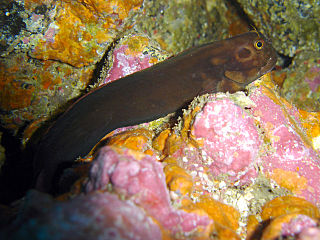
Ophioblennius atlanticus, also known as the redlip blenny and the horseface blenny, is a species of combtooth blenny, family Blenniidae, found primarily in the western central Atlantic ocean. Redlip blennies can be found in coral crests and shallow fringing reefs. They are highly territorial and attack intruders with two long, sharp canine teeth. The adults are found at depths of 10 to 20 meters, and the eggs are benthic. The adults may reach up to four inches in length when fully grown, and they have large reddish lips, from which they attained their names. Redlip blennies largely feed on algae.
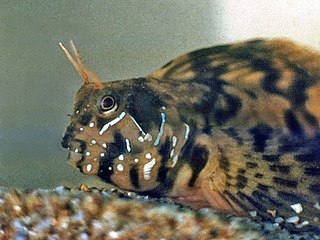
The sphinx blenny is a species of combtooth blenny, and the only species in the genus Aidablennius. It was described by Achille Valenciennes in 1836, originally under the genus Blennius, and was later reassigned under "Aidablennius" by Gilbert Percy Whitley in 1947. It is a subtropical blenny known from Morocco, in the eastern Atlantic Ocean, and also from the Mediterranean and Black Seas. Sphinx blennies inhabit shallow, rocky waters in the littoral zone, with sunlight exposure. They feed primarily on benthic algae, weeds and invertebrates. Sphinx blennies can measure up to 8 centimetres (3.1 in) long in total length.
Ophioblennius trinitatis is a species of combtooth blenny endemic to the southwest Atlantic ocean. It is a subtropical marine fish commonly found in reefs off the coast of Brazil. Combtooth blennies are often referred to as "peixes-macacos" in Brazil, which translates to "monkey-fish".
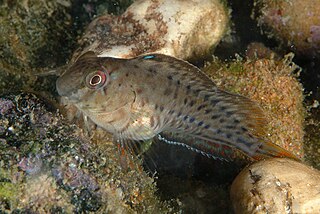
The rusty blenny or Black Sea blenny is a species of combtooth blenny found in the eastern Atlantic: Loire mouth, France to Morocco including the Mediterranean and Black Sea. This species reaches a length of 20 centimetres (7.9 in) TL.
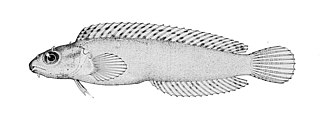
Petroscirtes variabilis, the variable sabretooth blenny, variable fangblenny, or the variable blenny, is a species of combtooth blenny found in the western Pacific and Indian Ocean. This species reaches a length of 15 centimetres (5.9 in) TL.

Plagiotremus phenax, the Imposter fangblenny, is a species of combtooth blenny found in coral reefs in the Indian Ocean. This species reaches a length of 8 centimetres (3.1 in) TL. This blenny uses bio mimicry to avoid predation, as it has a strong resemblance to the disco blenny.

Salaria basilisca is a species of combtooth blenny found in the Mediterranean Sea near Tunisia and Turkey, also in the Adriatic Sea. This species reaches a length of 18 centimetres (7.1 in) TL. It is found among seagrass, sometimes where there is a rocky substrate. The male guards the eggs produced by several females. They are protogynous hermaphrodites with individuals being females while young changing to males later.
Salarias sexfilum is a species of combtooth blenny found in the western central Pacific ocean, particularly the shallow fringing reefs and tide pools of Australia and Indonesia.

The yellow triplefin ,> also known as the Abel's triplefin in South Africa, is a species of triplefin in the genus Enneapterygius. Males in this species can reach a maximum length of 2.5 centimetres. The blennies are generally bright yellow in colour, and males have black heads. They feed mostly on benthic invertebrates.




















